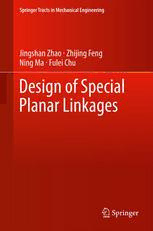
Design of Special Planar Linkages PDF
Preview Design of Special Planar Linkages
Springer Tracts in Mechanical Engineering Jingshan Zhao · Zhijing Feng Ning Ma · Fulei Chu Design of Special Planar Linkages Springer Tracts in Mechanical Engineering Forfurthervolumes: http://www.springer.com/series/11693 Jingshan Zhao • Zhijing Feng (cid:129) Ning Ma (cid:129) Fulei Chu Design of Special Planar Linkages 123 JingshanZhao ZhijingFeng NingMa FuleiChu TsinghuaUniversity Beijing China,People’sRepublic ISSN2195-9862 ISSN2195-9870(electronic) ISBN978-3-642-38447-9 ISBN978-3-642-38448-6(eBook) DOI10.1007/978-3-642-38448-6 SpringerHeidelbergNewYorkDordrechtLondon LibraryofCongressControlNumber:2013946254 ©Springer-VerlagBerlinHeidelberg2014 Thisworkissubjecttocopyright.AllrightsarereservedbythePublisher,whetherthewholeorpartof thematerialisconcerned,specificallytherightsoftranslation,reprinting,reuseofillustrations,recitation, broadcasting,reproductiononmicrofilmsorinanyotherphysicalway,andtransmissionorinformation storageandretrieval,electronicadaptation,computersoftware,orbysimilarordissimilarmethodology nowknownorhereafterdeveloped.Exemptedfromthislegalreservationarebriefexcerptsinconnection with reviews or scholarly analysis or material supplied specifically for the purpose of being entered and executed on a computer system, for exclusive use by the purchaser of the work. Duplication of this publication or parts thereof is permitted only under the provisions of the Copyright Law of the Publisher’slocation,initscurrentversion,andpermissionforusemustalwaysbeobtainedfromSpringer. PermissionsforusemaybeobtainedthroughRightsLinkattheCopyrightClearanceCenter.Violations areliabletoprosecutionundertherespectiveCopyrightLaw. Theuseofgeneraldescriptivenames,registerednames,trademarks,servicemarks,etc.inthispublication doesnotimply,evenintheabsenceofaspecificstatement,thatsuchnamesareexemptfromtherelevant protectivelawsandregulationsandthereforefreeforgeneraluse. While the advice and information in this book are believed to be true and accurate at the date of publication,neithertheauthorsnortheeditorsnorthepublishercanacceptanylegalresponsibilityfor anyerrorsoromissionsthatmaybemade.Thepublishermakesnowarranty,expressorimplied,with respecttothematerialcontainedherein. Printedonacid-freepaper SpringerispartofSpringerScience+BusinessMedia(www.springer.com) Preface Linkages are widely used in our life and work. Almost all planar linkages can be decomposedwithanumberofequivalentfour-barlinkageswhichareconsideredto beoneofthefundamentalmechanismforms.Asthesimplestclosedchainmecha- nism,planarfour-barlinkagesareextensivelyusedfrommechanicalengineeringto aerospaceengineeringandevencivilengineering. This book focuses on the design of a kind of special planar linkages which consist of a number of pivot jointed scissorlike elements (SLEs) in one or more different planes. These planar linkages are overconstrained in structure but allow to stretch or compact in some directions; therefore, they have the advantages of both truss and mechanism. However, the kinetostatics and dynamics of these linkages are different from their existing counterparts of trusses or mechanisms. Thestatics,kinematics,anddynamicsofsuchplanarlinkagesareimportanttopics in applications. We sincerely hope the book will be beneficial for mechanical engineers,robotdesignengineers,andresearchersinotherrelatedfields. Chapter 1 presents an overview of the pivot jointed planar linkages that will be investigated in this book. Some definitions, such as planar kinematic chain, mobility, planar linkages, workspace and singularity, design problems including statics design, kinematics design, and structural dynamics of planar linkages, are discussedinthischapter. Chapter 2 develops a uniform position design equation for planar four-bar linkages. According to Burmester theory, a general planar four-bar linkage could trace five arbitrary accurate positions at most. However, modern design often requiresamechanismtopreciselyorapproximatelytracemorepositions.Thetext starts from proposing a uniform equation for position design and then provides a proofforthesufficiencyandnecessity.Thealgorithmcansearchtheaccurateresults when there are such solutions for the specified n precise positions; otherwise, the best approximate solutions will be found. This permits the engineers to directly obtaintheplanarfour-barlinkageswhenthespecifiedpositionsareprescribed. Chapter 3 proposes a foldable stair which remains the walking conversions of human being and all advantages of concrete stair in civil engineering. The stair is discussed as a mechanism synthesis example with screw theory in accordance to v vi Preface thecommonconcretestairsbetweentwofloors.Itconsistsofanumberofidentical deployableSLEsthatformthestaircaseswhenexpanded.Theinstantaneousscrew of every stair represents the relative rotation and the rotation center of the stair. Theactuatorisaplanarfour-barlinkagewhichissynthesizedinlinewiththetwo extremepositionsofthestair,foldedandunfolded. Chapter4startsfromthediscussionofthenumberofpointsthataplanarfour-bar linkagecouldpreciselytraceandthenproposesanoncirculargear-coupledfive-bar linkage as a steering mechanism. It strictly follows the Ackermann steering rule comparedwiththeexistingfour-barsteeringlinkages.Therefore,themethodcanbe usedtodesignanykindofplanarfive-barlinkagetosatisfyaspecifiedfunctionof curves. Chapter 5 introduces the theoretical foundation for the workspace of planar parallel mechanism under rotational actuations and the algorithms to search the reachable and the dexterous workspace. Then singularity workspaces of such mechanismsarepresentedwithanapplicationexampleofaplanar3-RRRlinkage. The method and algorithm discussed in this chapter can be used to analyze other planarlinkages. Chapter6addressesthestaticsofsomespecialplanarlinkageswiththeexample of foldable stair proposed in Chap. 3. The statics of rigid-body system of the stair mechanism is first discussed. Because of the redundant constraints, the internal forcesareexaminedbyusingthesecondCastigliano’stheorem.Andthentheinner forces of every link are analyzed so that the engineers can execute an identical strengthdesign. Chapter 7 investigates the kinetostatics of overconstraint mechanisms which are made of double planar linkages. The mechanism is redundantly constrained in structureandthereforehasbothmeritsofhighstructuralstiffnessandstrengthofa trussstructureandmotionflexibilityofamechanism.Thekinetostaticsisdiscussed withthesynthesisofadeployablewingframeandtheliftmechanism. Chapter8discussesastructuraldynamicsalgorithmforfoldablelinkagesbased on transfer matrix. The foldable stair and deployable wing are all typical planar linkageswhicharemadeupofanumberofidenticalunits.Therefore,thedynamics ofeachlinkbetweeneverytwoadjacentrevolutejointsispreciselyexpressedbythe transfer matrixof Euler-Bernoulli beam withthe variables of boundary conditions of the joints. In this way, the structural dynamics of the whole structure can be developed by using the least variables compared with the traditional methods. In addition,thisalgorithmavoidstheproblemofthetraditionaltransfer-matrixmethod thatthenumberofvariablesgreatlyincreaseswhenthereareahugenumberofcross jointswithinastructure. Chapter9proposesafoldabletowerforsupportingwindturbinewhoseheightis changeable. The advantage of the flexibility to fold and unfold can be utilized for protecting the wind turbine when destructive weather comes. The dynamic equiv- alent stiffness of the foldable tower is investigated as the function of deployment angle of the actuator. To expand the applications of the foldable structures, multi- planar linkages and the topology changeable linkages are discussed at the end of thischapter. Preface vii Chapter10introducesthedesignoffoldablemountingequipmentforsolarcell panels. The equipment consists of a number of identical brackets to fix the solar cellpanels.Therefore, thischapter firstinvestigates thegeometry ofeach foldable unitandthenfocusesonstaticsofthestructureandsimulationexperiments.When the bracket is deployed, the frame of each unit forms the space for fastening the solar cell panels through fixtures. The merit of the structure is that the whole structureoccupieslessspacewhencompletelyfolded.Thisismostconvenientfor transporting and manufacturing because of its less occupied space when folded. Meanwhile,itisalsoavailabletoformarc-shapedoranyspatialcurvedspacepanels bychangingthepositionsofthemiddlejointsofscissorunitsinassembly. I am pleased to express my gratitude for the contribution of many teachers and colleagues whose work over the years has developed and clarified the design and analysis theory for overconstraint planar linkages. This book consists of results of theinsight,commitment,andhardworkbyJianyiWang,HoulinFang,XiangLiu, Li Ye, Zhengfang Yan, Zheng Cai, and Huichan Zhao. I have also benefitted from theinsightofmycoauthorsZhijingFeng,NingMa,andFuleiChu.Inaddition,Iam grateful for the inspiration of Wenxiu Lu, Ketao Zhang, Guowu Wei, Ligang Yao, DanielMartins,JianS.Dai,YuefaFang,andJ.MichaelMcCarthy. Finally,IgratefullyacknowledgethesupportoftheNaturalScienceFoundation ofChina,theNaturalScienceFoundationofBeijing,theFoundationfortheAuthor of National Excellent Doctoral Dissertation of China, and the Program for New Century Excellent Talents in University of Education Ministry of China and the supportofStateKeyLaboratoryofTribologyinTsinghuaUniversity. TsinghuaUniversity,Beijing,China JingshanZhao Contents 1 DesignRequirementsofPlanarFour-BarLinkages.................... 1 1.1 AnalysisofPlanarLinkages......................................... 1 1.1.1 PlanarKinematicChain.................................... 2 1.1.2 PlanarLinkages............................................. 2 1.1.3 WorkspaceandSingularity................................. 5 1.2 DesignofPlanarLinkages........................................... 5 1.2.1 PositionDesign............................................. 6 1.2.2 KinetostaticDesign......................................... 6 1.2.3 DynamicsDesign........................................... 7 1.3 ContentsoftheBook................................................. 10 1.4 Conclusions........................................................... 10 References.................................................................... 11 2 DesignofPlanarLinkageswithSpecifiedPositions .................... 13 2.1 Analysis of Planar Four-Bar Linkages withMultispecifiedPositions........................................ 13 2.2 Uniform Equation of Planar Four-Bar Linkages withnSpecifiedPositions ........................................... 15 2.2.1 General Requirements for Multiposition DesignofaPlanarFour-BarLinkage...................... 15 2.2.2 UniformEquationfortheDesignofaPlanar Four-BarLinkagewithnSpecifiedPositions ............. 20 2.3 ApplicationExamplesandDiscussions............................. 22 2.3.1 DesignofPlanarFour-BarLinkageswithFour AccuratePositions.......................................... 23 2.3.2 DesignofPlanarFour-BarLinkageswithFive Positions .................................................... 24 2.3.3 Design of Planar Four-Bar Linkages withMoreApproximatePositions......................... 26 2.4 Conclusions........................................................... 32 References.................................................................... 33 ix
